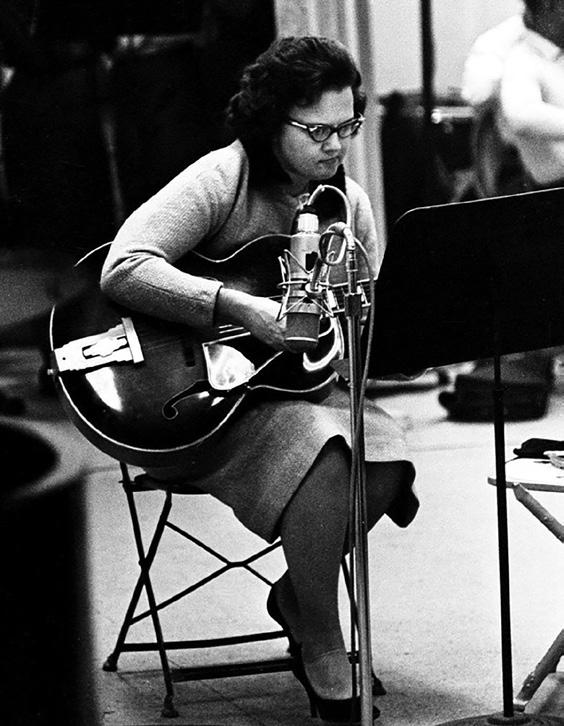
4 minute read
Youth Voice Column
Celebrating Nashville women Linda Martell and Velma Smith
It’s Women’s History Month and Girls Write Nashville is outlining great women in Nashville history online and in the pages of The Contributor. The Youth Voice Column is a partnership between The Contributor and Girls Write Nashville. In Girls Write Nashville, as well as their gender neutral wing Loudmouth Community Music, students are guided through the process of writing and recording original songs. In this project, youth writers will offer essays, poems and insight to The Contributor’s regular roster of stories.
Linda Martell
Linda Martell, vocalist, musician and performer, made history in 1969 as the first Black female solo artist to play the Grand Ole Opry.
Martell was born in 1941 in the small town of Leesville, South Carolina. Her father, Clarence, was a sharecropper and pastor, and her mother raised chickens. She was one of five children and grew up singing in a Gospel group with her brothers titled Linda Martell and the Angelos.
Martell was later discovered singing country music as a solo artist on an Air Force base. Here, she met a producer who signed her to his Nashville label in 1969. The same year, the label released her country cover of “Color Him Father.” The song became a charting single on the Billboard charts and her debut album followed in 1970.
As a Black woman singing in a genre dominated and appropriated by white artists, Martell experienced horrendous levels of racism. “I remember that well,” she said in a Rolling Stone interview. “You’d be singing and they’d shout out names and you know the names they would call you.”
Tiffany Minton, a musician and popular music historian with the Center for Pop Music, wrote of Martell, “So regarding Linda’s authorship of her own material, I have a few thoughts. I’m inclined to believe she did write her own material. However, according to the back album cover, her songs on Color Me Country are written by many people other than her. It was Linda Martell and Velma Smith
all too common to defer to hired songwriters back then, because of the industry support for it and tradition of the profession as being standard. Add to that her race, and I can’t see much opportunity for her to have done anything differently other than to sing songs white people wrote. Notably, her B-side to “Color Him Father” is a pop county rendition of the famous gospel song “Amen” which became known as “Amen, Brother” when an instrumental version was done by The Winstons. The Winston’s “Amen, Brother” is now thought of as the most sampled drum break in hip-hop history. So I think we can talk about Linda’s music as part of this continuity of Black consciousness in popular music, for sure. That is to say, Black people have always been part of everything white folks have (string band, country, bluegrass, etc.) and more when it comes to what is considered “canon” in American popular music history. “
Martell continued to work as a musician for 20 years until her father’s death in 1990, when she returned home to South Carolina.
For the last 30 years, Martell has lived quietly in South Carolina, working as a children’s bus driver, and staying close to family. According to a Rolling Stone article, she is beginning to feel ready to share her story as a trailblazing musician. “That was a time and a half,” she says. “Don’t get me wrong. There were some beautiful people. And some not that beautiful.”
Fifty years after her only full length album, Martell is beginning to receive the acknowledgement as a trailblazing country artist who would not allow white supremacy and prejudice to silence her authentic country voice.
Velma Smith

Velma Smith was a country guitarist and the only female member of the RCA Studio B’s “A-Team” of studio musicians during the era of The Nashville Sound. This group of musicians are widely acclaimed for their work in the 1950s-1970s as the backing band for artists such as Elvis Presley, Patsy Cline, Bob Dylan and more.
Careers as an instrumentalist and studio musician have long been dominated by male musicians. According to Dr. Stacy L. Smith’s “Inclusion in the Recording Studio” report, women make up 21.7 percent of artists, 12.3 percent of songwriters and 2.1 percent of producers in popular music from 2012-2018. Smith, who died in 2014, was truly a trailblazer as a female session musician in the 1950’s male-dominated recording industry.
Smith’s career began in 1939 when high-profile bluegrass musician Bill Monroe heard Smith and her sister on a local radio feature and invited them to audition at the Grand Ole Opry. When her sister decided to focus on raising a family and did not want to pursue a career in music, Velma hit the road as a guitarist for Roy Acuff.
She retired from touring in the ’50s to focus her attention on recording session work as a member of the RCA A-Team, a team of Nashville’s most skilled musicians, working on some of the era’s most famous country recordings. She is believed to be the first female recording session musician in Nashville, according to a Tennessean article published after her death.
Two years after her passing, she was inducted into the Musicians Hall of Fame.
“ANAMATRONIC”
BY ANYA BOOTH GIRLS WRITE NASHVILLE
We wanna take away the pain
A supplement for today
We wanna see her gears turn
I promise it won’t hurt
Anamatronic girl
Your brain is a world
Let us take control
Rinse and repeat
They want to supplement my pain
So I don’t feel the burns
So that I can’t hurt
They want me to be numb
I feel dumb
I want away from this place
I don’t wanna be reprogrammed








